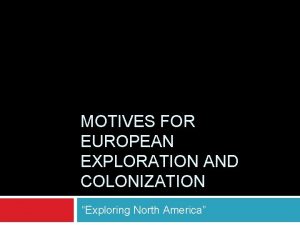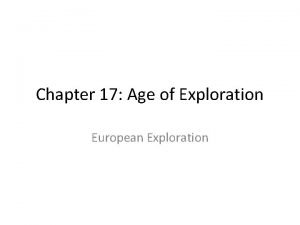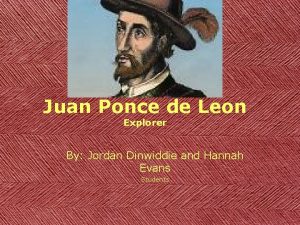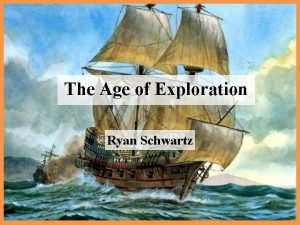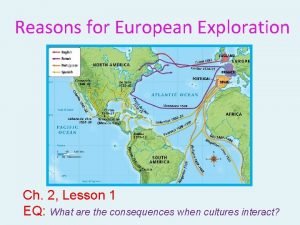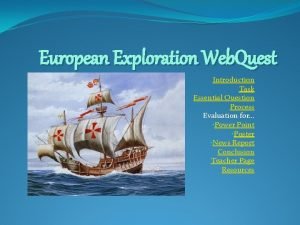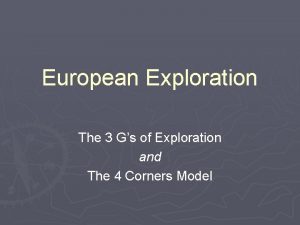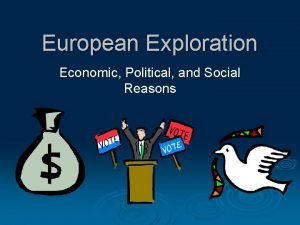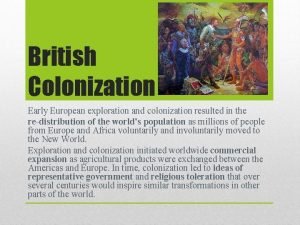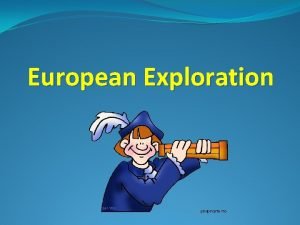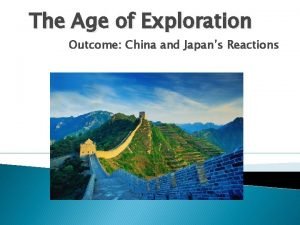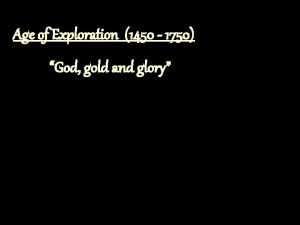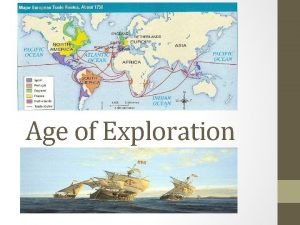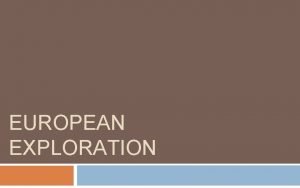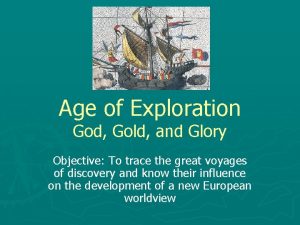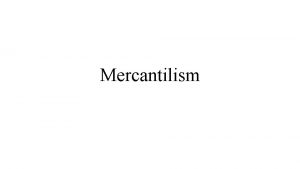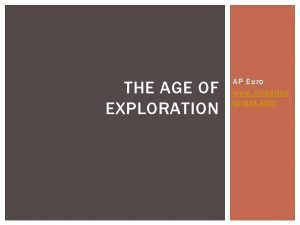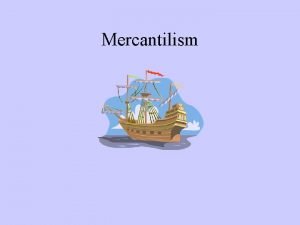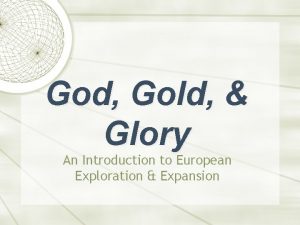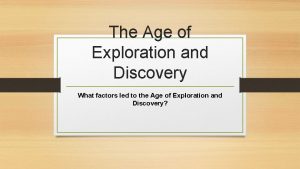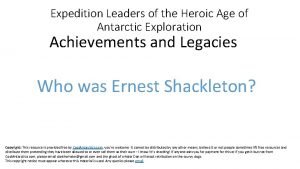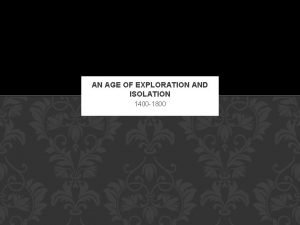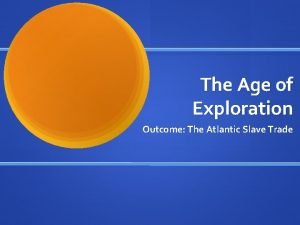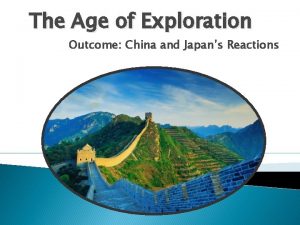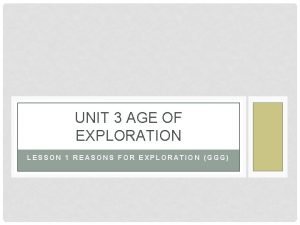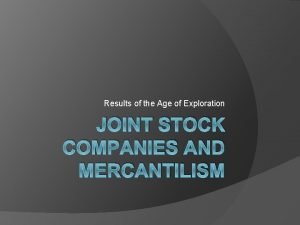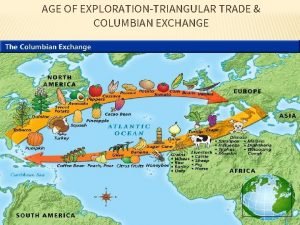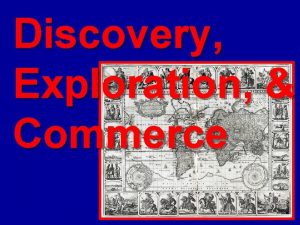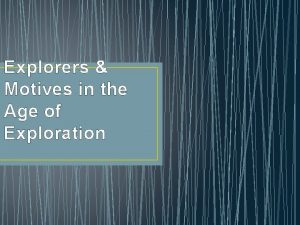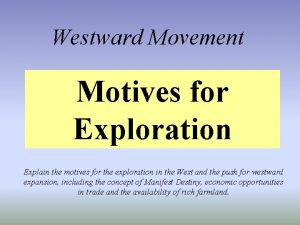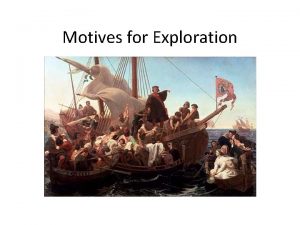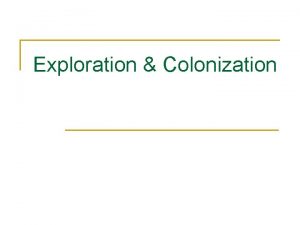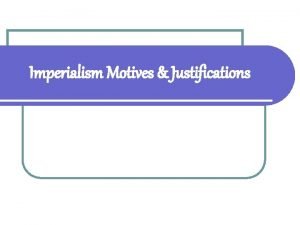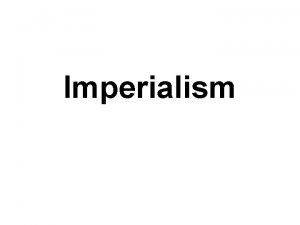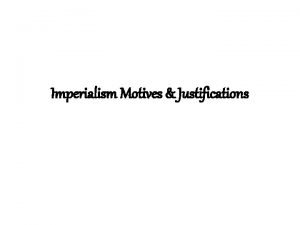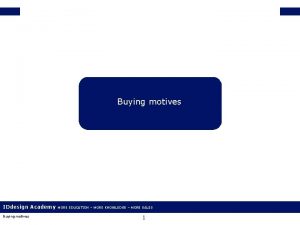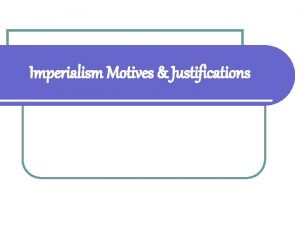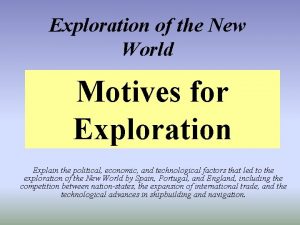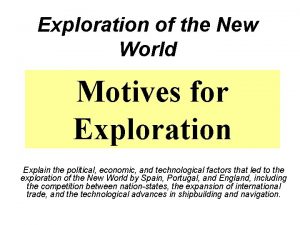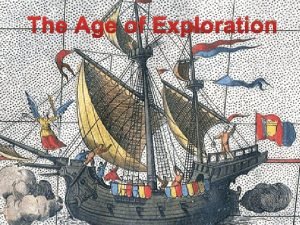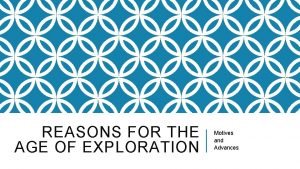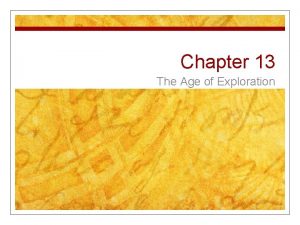Age of Exploration Motives for European Exploration 1


































- Slides: 34

Age of Exploration


Motives for European Exploration 1. Crusades • Silk trade route through Middle eastern lands rule by Islamic powers • Far East has Spices wealthy Europeans want 2. Renaissance curiosity about other lands and peoples. 3. Reformation refugees & missionaries. 4. Money seeking new sources of revenue Mercantilism – economic theory of selling more than you need more resources, led to colonization


Portugal Sails East • Prince Henry - explores African coast. • The Portuguese could convert the Africans to Christianity. • Find riches in Africa • Find an easier way to reach Asia - going around Africa.

Prince Henry the Navigator

D I a s

Seeking India • Vasco da Gama Portuguese • Rounded the Cape of Good Hope and made it to India • Portuguese had seized key ports around the Indian Ocean and built a trading empire becoming a world power

Vasco da Gama

Columbus Sails West • Christopher Columbus wanted to reach the East Indies, today part of Indonesia by sailing west across the Atlantic. • Ferdinand Isabella of Spain agreed to financed his voyage.

Columbus

• The pope divided the non-European world into two zones in the Treaty of Tordesillas. • Trading and exploration rights • Spain - west • Portugal - east Dividing the Globe in Half

The Search for a Direct • The English, Dutch, and Route Continues French explored the coast of North America looking for a “northwest passage, ” or a route from the Atlantic Ocean to the Pacific Ocean

Ferdinand Magellan

Rise of the Dutch in Asia • Wealthy Dutch merchants formed the Dutch East India Company to gain the spice trade. • Dutch East India Company had full sovereign powers. – built armies – wage war – negotiate peace treaties – govern overseas territory


• Spanish conquerors arrived in the Americas. Conquistadors

Guns, Germs, and Steel • Conquistadors had many advantages. • Guns and cannons -superior to arrows and spears • Metal armor provided protection. • Horses • Disease - Europeans unknowingly carried diseases (Native had no immunity) – Smallpox – Measles – Influenza


Cortés and the Aztecs • Hernándo Cortés - Mexico • Tenochtitlán - Aztec Capital • Aztec emperor Montezuma is notified that the Spanish are in Mexico • Sent gifts to Cortés and urged him to not to come into the empire • Cortés only interested in gold and silver – was not stopping


Tenochtitlán Falls to the Spanish • Spanish wanted to convert Aztecs to Christianity. • Spanish imprisoned Montezuma - gain control of riches. • Wars breakout (Spanish vs Aztecs) • Aztecs drove the Spanish from the city • Montezuma is killed. • Cortés returns and destroys the Aztec capital • The Spanish later built Mexico City on the ruins of Tenochtitlán



• Francisco Pizarro conquered the Incan empire in Peru • Atahualpa refused convert to Christianity. • Atahualpa is captured • The Spanish demanded a huge ransom for the ruler. The Inca paid it, but the Spanish killed Atahualpa anyway. Pizarro Takes Peru

• Millions of Native Americans were conquered. • Used Native American labor to establish silver mines the new world • With this wealth, Spain became Europe’s greatest power. • Natives believed this was the world’s end. • Hundreds of thousands of natives died


Horrors of the Middle Passage Most Africans were taken from inland villages. Forced to march to coastal ports. Many captives died along the way. Some tried to escape, and were often quickly recaptured an punished. • They were held there until European traders arrived by ship. • •

Slave Ship “Middle Passage”

The Columbian Exchange • A vast global exchange of new foods and animals that would profoundly affect the world. • Began with Columbus - Columbian Exchange. • Europeans found - tomatoes, pumpkins, peppers, corn, potatoes • Europeans carried plants and animals to the Americas- wheat , grapes, bananas, sugar cane , Cattle, pigs, goats, and chickens • Horses and donkeys = transportation

The “Columbian Exchange” Squash Avocado Peppers Sweet Potatoes Turkey Pumpkin Tobacco Quinine Cocoa Pineapple Cassava POTATO Peanut TOMATO Vanilla MAIZE Syphilis Trinkets Liquor GUNS Olive COFFEE BEAN Banana Rice Onion Turnip Honeybee Barley Grape Peach SUGAR CANE Oats Citrus Fruits Pear Wheat HORSE Cattle Sheep Pigs Smallpo x

Capitalism Emerges • Economic system in which most businesses are owned privately. • Entrepreneurs, or people who take on financial risk to make profits, were key to the success of capitalism. • Used colonies for raw materials

Mercantilism Arises • Monarch adopted the economic policy of mercantilism • National economies would be stronger • Mercantilists believed that a nation’s real wealth was measured in gold and silver • Exports >Imports • Colonies existed for the benefit of the parent country. • provided raw materials • Serves as a market for parent country • Mother countries imposed tariffs, or taxes on imported goods.

Impact of European Expansion • • • Native populations ravaged by disease. High death rate New products introduced across the continents [“Columbian Exchange”]. Deepened colonial rivalries.
 Henry hudson motives for exploration
Henry hudson motives for exploration Age of exploration motives
Age of exploration motives Juan ponce de leon route map
Juan ponce de leon route map Vasco nunez de balboa motives for exploration
Vasco nunez de balboa motives for exploration Ponce de leon motives for exploration
Ponce de leon motives for exploration Iron age dates
Iron age dates Iron age bronze age stone age timeline
Iron age bronze age stone age timeline European exploration map
European exploration map European exploration webquest
European exploration webquest What were the 3 gs during the age of exploration
What were the 3 gs during the age of exploration European exploration economic reasons
European exploration economic reasons Early european exploration and colonization resulted in -
Early european exploration and colonization resulted in - What factors encouraged european exploration?
What factors encouraged european exploration? 3 g's
3 g's The age of exploration outcome china and japan's reactions
The age of exploration outcome china and japan's reactions Age of exploration diagram
Age of exploration diagram Age of exploration gold
Age of exploration gold The age of exploration definition
The age of exploration definition God gold and glory motivations for the age of exploration
God gold and glory motivations for the age of exploration Age of exploration glory
Age of exploration glory Chapter 19 an age of exploration and isolation
Chapter 19 an age of exploration and isolation Age of exploration ap euro
Age of exploration ap euro Age of exploration videos
Age of exploration videos Age of exploration saq
Age of exploration saq Mercantilism during the age of exploration
Mercantilism during the age of exploration Age of exploration vocab
Age of exploration vocab Gold god glory
Gold god glory What factors led to the age of exploration
What factors led to the age of exploration Cool antarctica.com
Cool antarctica.com Dutch exploration routes
Dutch exploration routes The age of exploration outcome the atlantic slave trade
The age of exploration outcome the atlantic slave trade The age of exploration outcome china and japan's reactions
The age of exploration outcome china and japan's reactions The age of exploration lesson 1
The age of exploration lesson 1 Mercantilism
Mercantilism Columbian exchange triangular trade
Columbian exchange triangular trade
